Comprehensive Literature Review: Workplace Bullying in Healthcare
VerifiedAdded on 2023/01/20
|13
|3502
|81
Literature Review
AI Summary
This literature review examines workplace bullying within the healthcare setting, exploring its history, influencing factors, and organizational culture. The review delves into the impact of bullying, including its effects on employee job satisfaction and organizational performance. It discusses individual and organizational factors contributing to bullying, such as gender, age, strict norms, and leadership theories. The paper analyzes leadership theories, explores the prevalence of bullying in various healthcare settings, and recommends prevention measures and intervention tools. The review also highlights current findings, the role of managerial support, and the importance of awareness. The methodology involves an integrative review of peer-reviewed articles from databases like Google Scholar, PsycInfo, and PubMed. The review concludes by emphasizing the need for understanding the social, organizational, and psychological aspects of workplace bullying in healthcare to mitigate its negative effects. The paper is contributed by a student and is available on Desklib, a platform providing AI-based study tools for students.
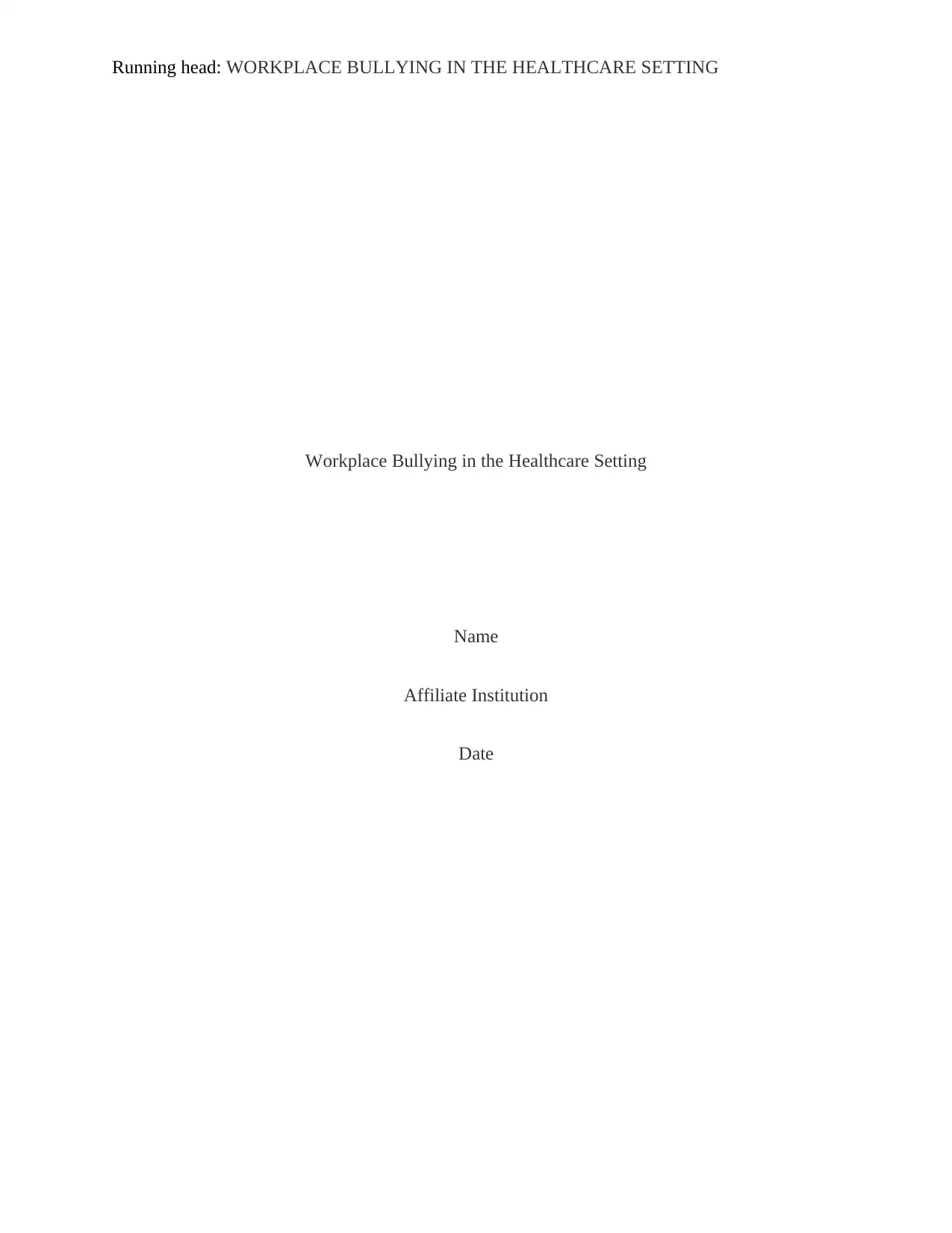
Running head: WORKPLACE BULLYING IN THE HEALTHCARE SETTING
Workplace Bullying in the Healthcare Setting
Name
Affiliate Institution
Date
Workplace Bullying in the Healthcare Setting
Name
Affiliate Institution
Date
Paraphrase This Document
Need a fresh take? Get an instant paraphrase of this document with our AI Paraphraser
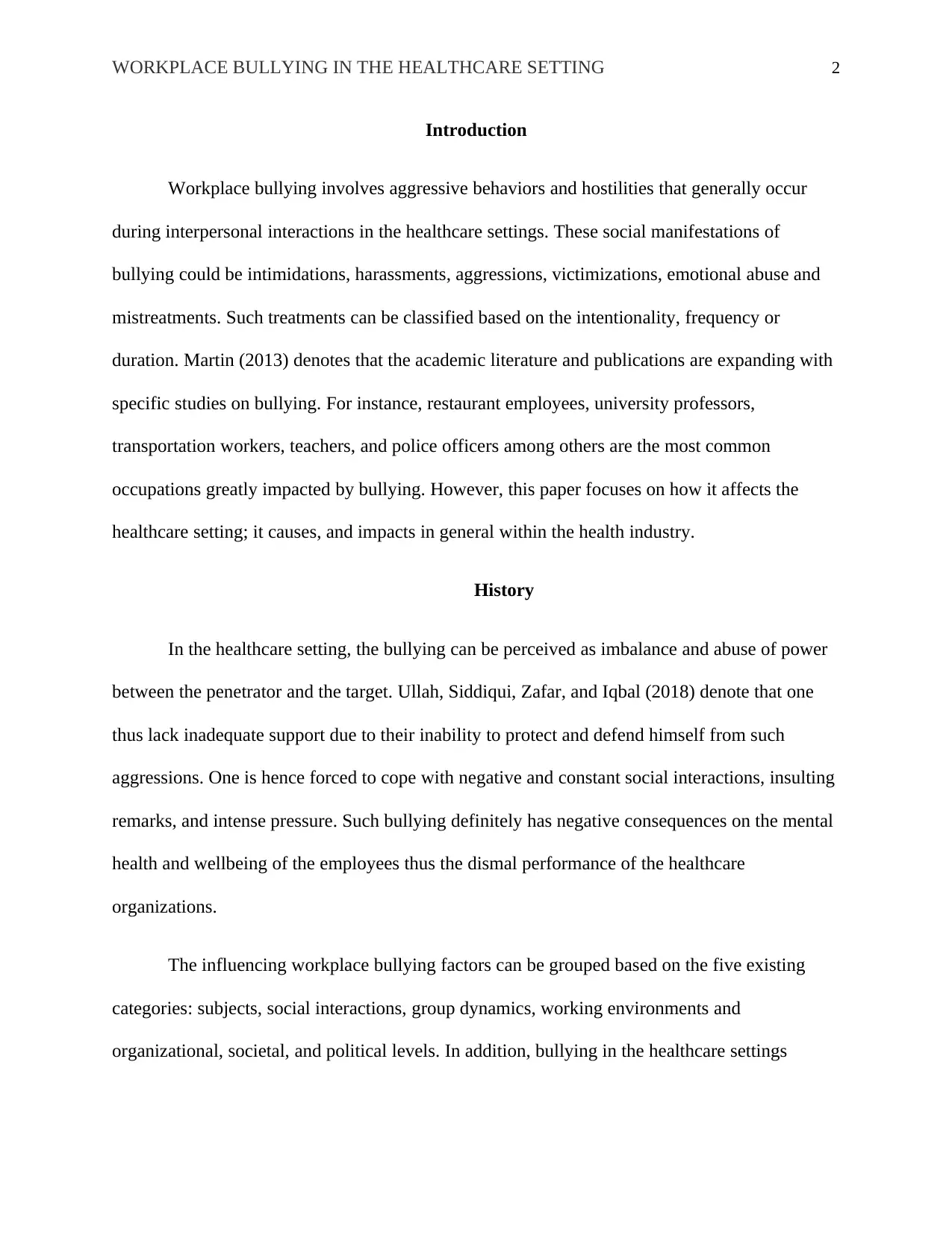
WORKPLACE BULLYING IN THE HEALTHCARE SETTING 2
Introduction
Workplace bullying involves aggressive behaviors and hostilities that generally occur
during interpersonal interactions in the healthcare settings. These social manifestations of
bullying could be intimidations, harassments, aggressions, victimizations, emotional abuse and
mistreatments. Such treatments can be classified based on the intentionality, frequency or
duration. Martin (2013) denotes that the academic literature and publications are expanding with
specific studies on bullying. For instance, restaurant employees, university professors,
transportation workers, teachers, and police officers among others are the most common
occupations greatly impacted by bullying. However, this paper focuses on how it affects the
healthcare setting; it causes, and impacts in general within the health industry.
History
In the healthcare setting, the bullying can be perceived as imbalance and abuse of power
between the penetrator and the target. Ullah, Siddiqui, Zafar, and Iqbal (2018) denote that one
thus lack inadequate support due to their inability to protect and defend himself from such
aggressions. One is hence forced to cope with negative and constant social interactions, insulting
remarks, and intense pressure. Such bullying definitely has negative consequences on the mental
health and wellbeing of the employees thus the dismal performance of the healthcare
organizations.
The influencing workplace bullying factors can be grouped based on the five existing
categories: subjects, social interactions, group dynamics, working environments and
organizational, societal, and political levels. In addition, bullying in the healthcare settings
Introduction
Workplace bullying involves aggressive behaviors and hostilities that generally occur
during interpersonal interactions in the healthcare settings. These social manifestations of
bullying could be intimidations, harassments, aggressions, victimizations, emotional abuse and
mistreatments. Such treatments can be classified based on the intentionality, frequency or
duration. Martin (2013) denotes that the academic literature and publications are expanding with
specific studies on bullying. For instance, restaurant employees, university professors,
transportation workers, teachers, and police officers among others are the most common
occupations greatly impacted by bullying. However, this paper focuses on how it affects the
healthcare setting; it causes, and impacts in general within the health industry.
History
In the healthcare setting, the bullying can be perceived as imbalance and abuse of power
between the penetrator and the target. Ullah, Siddiqui, Zafar, and Iqbal (2018) denote that one
thus lack inadequate support due to their inability to protect and defend himself from such
aggressions. One is hence forced to cope with negative and constant social interactions, insulting
remarks, and intense pressure. Such bullying definitely has negative consequences on the mental
health and wellbeing of the employees thus the dismal performance of the healthcare
organizations.
The influencing workplace bullying factors can be grouped based on the five existing
categories: subjects, social interactions, group dynamics, working environments and
organizational, societal, and political levels. In addition, bullying in the healthcare settings
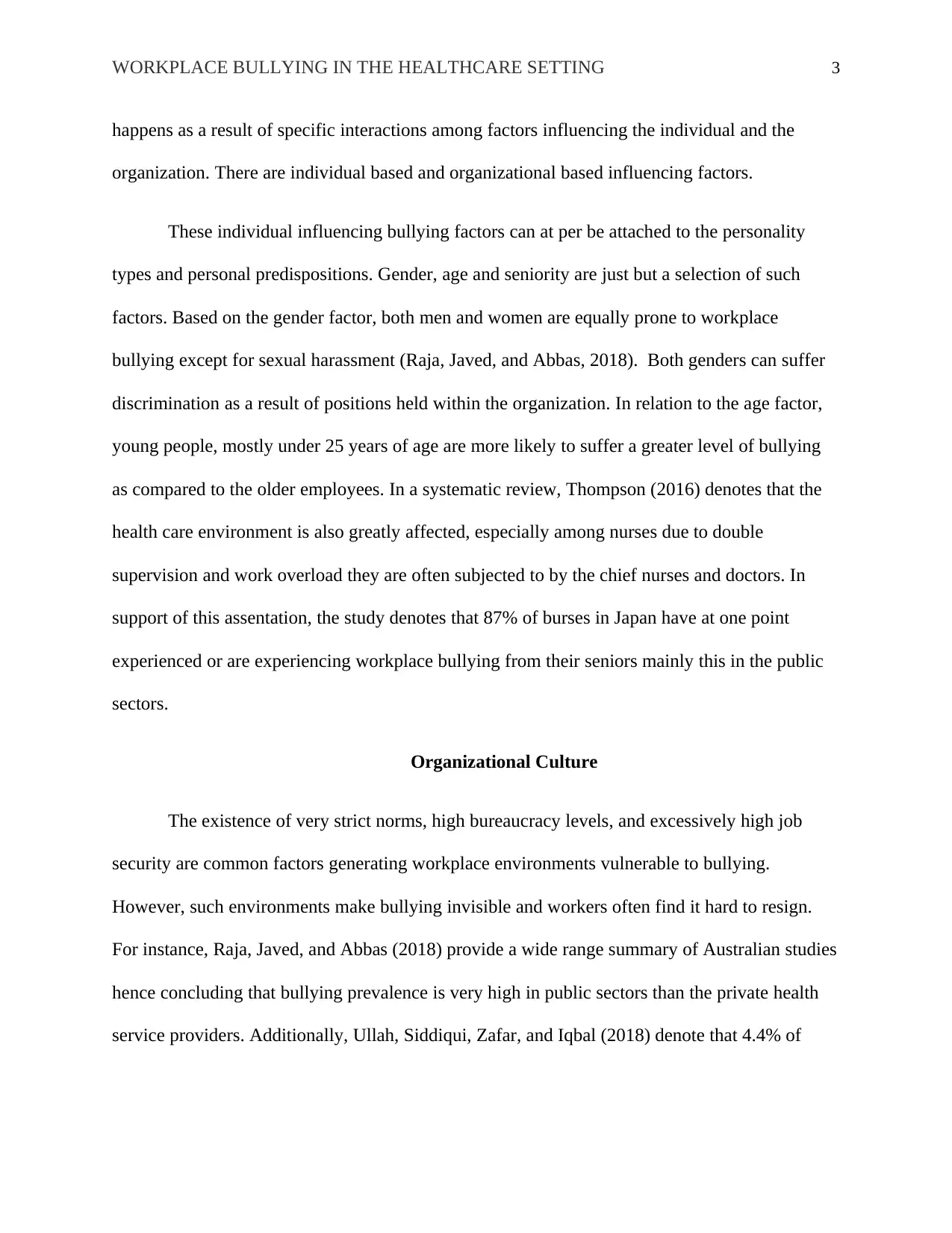
WORKPLACE BULLYING IN THE HEALTHCARE SETTING 3
happens as a result of specific interactions among factors influencing the individual and the
organization. There are individual based and organizational based influencing factors.
These individual influencing bullying factors can at per be attached to the personality
types and personal predispositions. Gender, age and seniority are just but a selection of such
factors. Based on the gender factor, both men and women are equally prone to workplace
bullying except for sexual harassment (Raja, Javed, and Abbas, 2018). Both genders can suffer
discrimination as a result of positions held within the organization. In relation to the age factor,
young people, mostly under 25 years of age are more likely to suffer a greater level of bullying
as compared to the older employees. In a systematic review, Thompson (2016) denotes that the
health care environment is also greatly affected, especially among nurses due to double
supervision and work overload they are often subjected to by the chief nurses and doctors. In
support of this assentation, the study denotes that 87% of burses in Japan have at one point
experienced or are experiencing workplace bullying from their seniors mainly this in the public
sectors.
Organizational Culture
The existence of very strict norms, high bureaucracy levels, and excessively high job
security are common factors generating workplace environments vulnerable to bullying.
However, such environments make bullying invisible and workers often find it hard to resign.
For instance, Raja, Javed, and Abbas (2018) provide a wide range summary of Australian studies
hence concluding that bullying prevalence is very high in public sectors than the private health
service providers. Additionally, Ullah, Siddiqui, Zafar, and Iqbal (2018) denote that 4.4% of
happens as a result of specific interactions among factors influencing the individual and the
organization. There are individual based and organizational based influencing factors.
These individual influencing bullying factors can at per be attached to the personality
types and personal predispositions. Gender, age and seniority are just but a selection of such
factors. Based on the gender factor, both men and women are equally prone to workplace
bullying except for sexual harassment (Raja, Javed, and Abbas, 2018). Both genders can suffer
discrimination as a result of positions held within the organization. In relation to the age factor,
young people, mostly under 25 years of age are more likely to suffer a greater level of bullying
as compared to the older employees. In a systematic review, Thompson (2016) denotes that the
health care environment is also greatly affected, especially among nurses due to double
supervision and work overload they are often subjected to by the chief nurses and doctors. In
support of this assentation, the study denotes that 87% of burses in Japan have at one point
experienced or are experiencing workplace bullying from their seniors mainly this in the public
sectors.
Organizational Culture
The existence of very strict norms, high bureaucracy levels, and excessively high job
security are common factors generating workplace environments vulnerable to bullying.
However, such environments make bullying invisible and workers often find it hard to resign.
For instance, Raja, Javed, and Abbas (2018) provide a wide range summary of Australian studies
hence concluding that bullying prevalence is very high in public sectors than the private health
service providers. Additionally, Ullah, Siddiqui, Zafar, and Iqbal (2018) denote that 4.4% of
⊘ This is a preview!⊘
Do you want full access?
Subscribe today to unlock all pages.

Trusted by 1+ million students worldwide
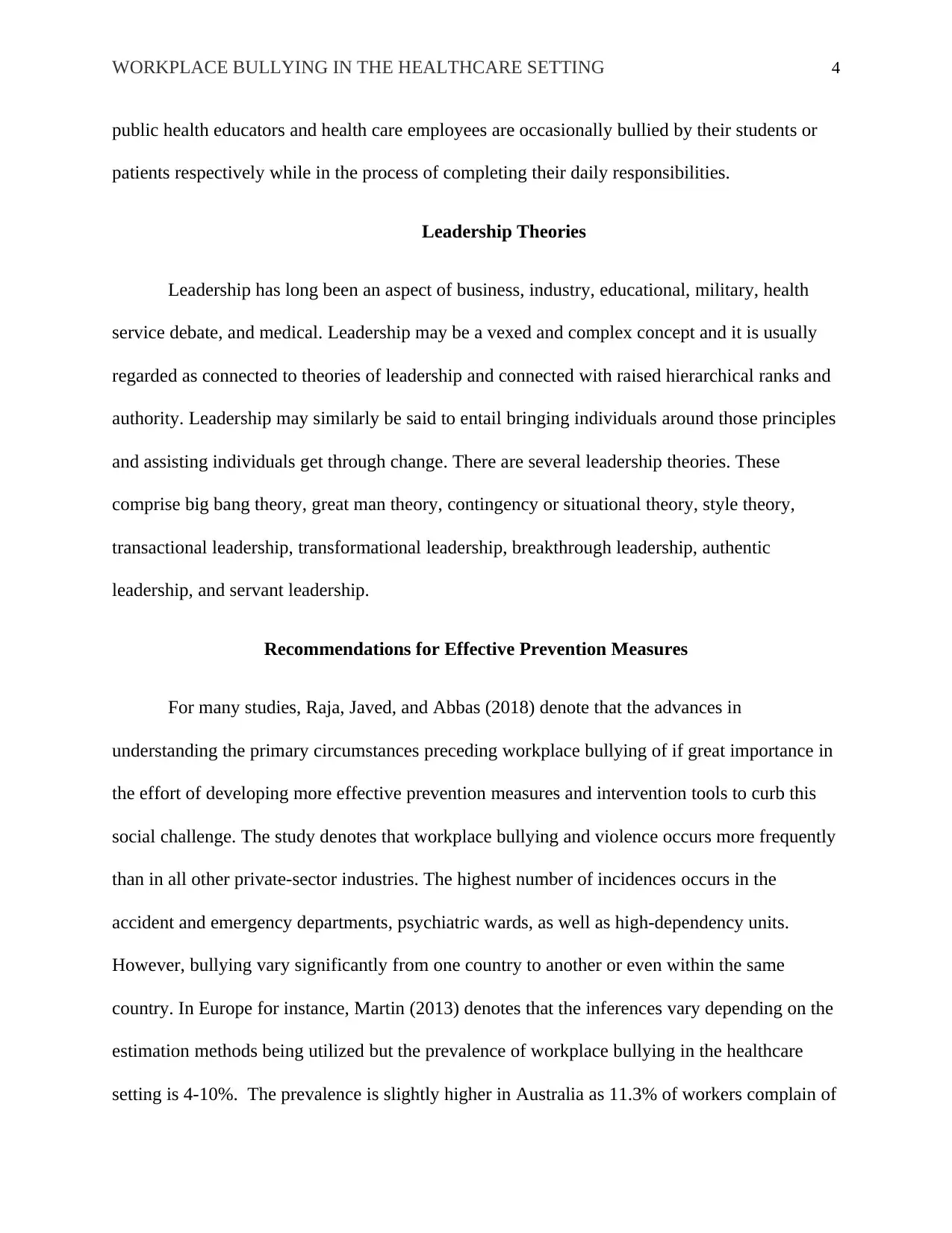
WORKPLACE BULLYING IN THE HEALTHCARE SETTING 4
public health educators and health care employees are occasionally bullied by their students or
patients respectively while in the process of completing their daily responsibilities.
Leadership Theories
Leadership has long been an aspect of business, industry, educational, military, health
service debate, and medical. Leadership may be a vexed and complex concept and it is usually
regarded as connected to theories of leadership and connected with raised hierarchical ranks and
authority. Leadership may similarly be said to entail bringing individuals around those principles
and assisting individuals get through change. There are several leadership theories. These
comprise big bang theory, great man theory, contingency or situational theory, style theory,
transactional leadership, transformational leadership, breakthrough leadership, authentic
leadership, and servant leadership.
Recommendations for Effective Prevention Measures
For many studies, Raja, Javed, and Abbas (2018) denote that the advances in
understanding the primary circumstances preceding workplace bullying of if great importance in
the effort of developing more effective prevention measures and intervention tools to curb this
social challenge. The study denotes that workplace bullying and violence occurs more frequently
than in all other private-sector industries. The highest number of incidences occurs in the
accident and emergency departments, psychiatric wards, as well as high-dependency units.
However, bullying vary significantly from one country to another or even within the same
country. In Europe for instance, Martin (2013) denotes that the inferences vary depending on the
estimation methods being utilized but the prevalence of workplace bullying in the healthcare
setting is 4-10%. The prevalence is slightly higher in Australia as 11.3% of workers complain of
public health educators and health care employees are occasionally bullied by their students or
patients respectively while in the process of completing their daily responsibilities.
Leadership Theories
Leadership has long been an aspect of business, industry, educational, military, health
service debate, and medical. Leadership may be a vexed and complex concept and it is usually
regarded as connected to theories of leadership and connected with raised hierarchical ranks and
authority. Leadership may similarly be said to entail bringing individuals around those principles
and assisting individuals get through change. There are several leadership theories. These
comprise big bang theory, great man theory, contingency or situational theory, style theory,
transactional leadership, transformational leadership, breakthrough leadership, authentic
leadership, and servant leadership.
Recommendations for Effective Prevention Measures
For many studies, Raja, Javed, and Abbas (2018) denote that the advances in
understanding the primary circumstances preceding workplace bullying of if great importance in
the effort of developing more effective prevention measures and intervention tools to curb this
social challenge. The study denotes that workplace bullying and violence occurs more frequently
than in all other private-sector industries. The highest number of incidences occurs in the
accident and emergency departments, psychiatric wards, as well as high-dependency units.
However, bullying vary significantly from one country to another or even within the same
country. In Europe for instance, Martin (2013) denotes that the inferences vary depending on the
estimation methods being utilized but the prevalence of workplace bullying in the healthcare
setting is 4-10%. The prevalence is slightly higher in Australia as 11.3% of workers complain of
Paraphrase This Document
Need a fresh take? Get an instant paraphrase of this document with our AI Paraphraser
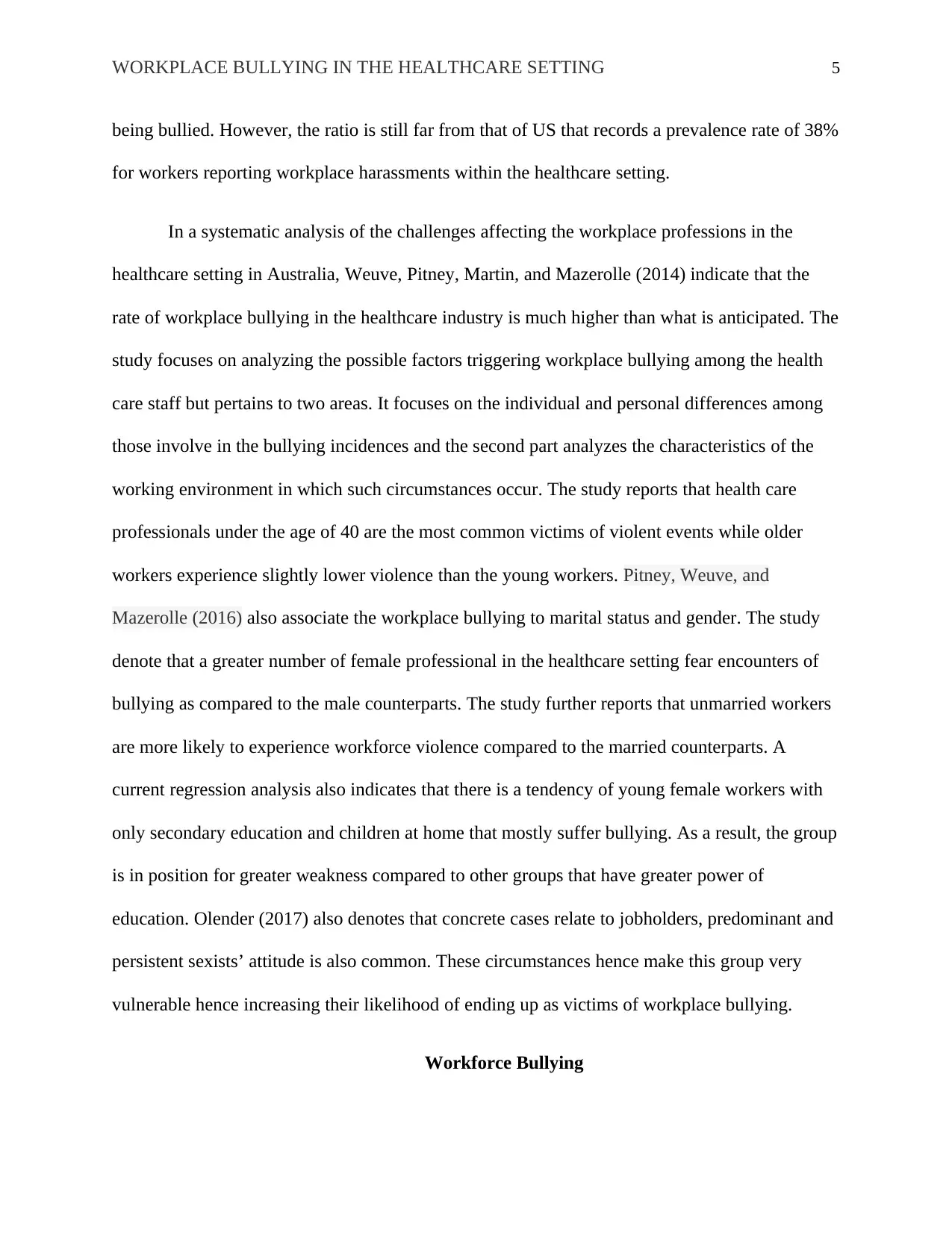
WORKPLACE BULLYING IN THE HEALTHCARE SETTING 5
being bullied. However, the ratio is still far from that of US that records a prevalence rate of 38%
for workers reporting workplace harassments within the healthcare setting.
In a systematic analysis of the challenges affecting the workplace professions in the
healthcare setting in Australia, Weuve, Pitney, Martin, and Mazerolle (2014) indicate that the
rate of workplace bullying in the healthcare industry is much higher than what is anticipated. The
study focuses on analyzing the possible factors triggering workplace bullying among the health
care staff but pertains to two areas. It focuses on the individual and personal differences among
those involve in the bullying incidences and the second part analyzes the characteristics of the
working environment in which such circumstances occur. The study reports that health care
professionals under the age of 40 are the most common victims of violent events while older
workers experience slightly lower violence than the young workers. Pitney, Weuve, and
Mazerolle (2016) also associate the workplace bullying to marital status and gender. The study
denote that a greater number of female professional in the healthcare setting fear encounters of
bullying as compared to the male counterparts. The study further reports that unmarried workers
are more likely to experience workforce violence compared to the married counterparts. A
current regression analysis also indicates that there is a tendency of young female workers with
only secondary education and children at home that mostly suffer bullying. As a result, the group
is in position for greater weakness compared to other groups that have greater power of
education. Olender (2017) also denotes that concrete cases relate to jobholders, predominant and
persistent sexists’ attitude is also common. These circumstances hence make this group very
vulnerable hence increasing their likelihood of ending up as victims of workplace bullying.
Workforce Bullying
being bullied. However, the ratio is still far from that of US that records a prevalence rate of 38%
for workers reporting workplace harassments within the healthcare setting.
In a systematic analysis of the challenges affecting the workplace professions in the
healthcare setting in Australia, Weuve, Pitney, Martin, and Mazerolle (2014) indicate that the
rate of workplace bullying in the healthcare industry is much higher than what is anticipated. The
study focuses on analyzing the possible factors triggering workplace bullying among the health
care staff but pertains to two areas. It focuses on the individual and personal differences among
those involve in the bullying incidences and the second part analyzes the characteristics of the
working environment in which such circumstances occur. The study reports that health care
professionals under the age of 40 are the most common victims of violent events while older
workers experience slightly lower violence than the young workers. Pitney, Weuve, and
Mazerolle (2016) also associate the workplace bullying to marital status and gender. The study
denote that a greater number of female professional in the healthcare setting fear encounters of
bullying as compared to the male counterparts. The study further reports that unmarried workers
are more likely to experience workforce violence compared to the married counterparts. A
current regression analysis also indicates that there is a tendency of young female workers with
only secondary education and children at home that mostly suffer bullying. As a result, the group
is in position for greater weakness compared to other groups that have greater power of
education. Olender (2017) also denotes that concrete cases relate to jobholders, predominant and
persistent sexists’ attitude is also common. These circumstances hence make this group very
vulnerable hence increasing their likelihood of ending up as victims of workplace bullying.
Workforce Bullying
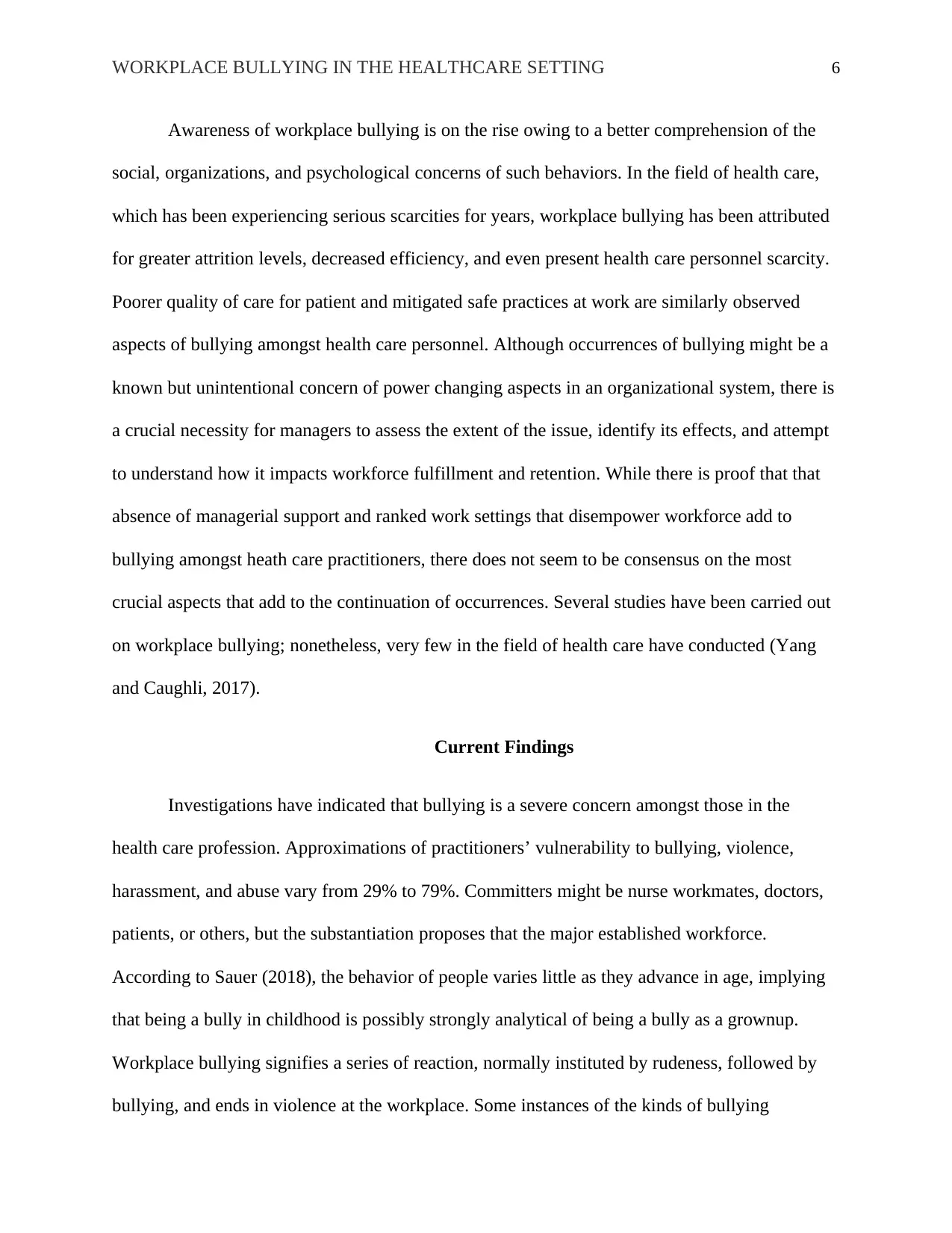
WORKPLACE BULLYING IN THE HEALTHCARE SETTING 6
Awareness of workplace bullying is on the rise owing to a better comprehension of the
social, organizations, and psychological concerns of such behaviors. In the field of health care,
which has been experiencing serious scarcities for years, workplace bullying has been attributed
for greater attrition levels, decreased efficiency, and even present health care personnel scarcity.
Poorer quality of care for patient and mitigated safe practices at work are similarly observed
aspects of bullying amongst health care personnel. Although occurrences of bullying might be a
known but unintentional concern of power changing aspects in an organizational system, there is
a crucial necessity for managers to assess the extent of the issue, identify its effects, and attempt
to understand how it impacts workforce fulfillment and retention. While there is proof that that
absence of managerial support and ranked work settings that disempower workforce add to
bullying amongst heath care practitioners, there does not seem to be consensus on the most
crucial aspects that add to the continuation of occurrences. Several studies have been carried out
on workplace bullying; nonetheless, very few in the field of health care have conducted (Yang
and Caughli, 2017).
Current Findings
Investigations have indicated that bullying is a severe concern amongst those in the
health care profession. Approximations of practitioners’ vulnerability to bullying, violence,
harassment, and abuse vary from 29% to 79%. Committers might be nurse workmates, doctors,
patients, or others, but the substantiation proposes that the major established workforce.
According to Sauer (2018), the behavior of people varies little as they advance in age, implying
that being a bully in childhood is possibly strongly analytical of being a bully as a grownup.
Workplace bullying signifies a series of reaction, normally instituted by rudeness, followed by
bullying, and ends in violence at the workplace. Some instances of the kinds of bullying
Awareness of workplace bullying is on the rise owing to a better comprehension of the
social, organizations, and psychological concerns of such behaviors. In the field of health care,
which has been experiencing serious scarcities for years, workplace bullying has been attributed
for greater attrition levels, decreased efficiency, and even present health care personnel scarcity.
Poorer quality of care for patient and mitigated safe practices at work are similarly observed
aspects of bullying amongst health care personnel. Although occurrences of bullying might be a
known but unintentional concern of power changing aspects in an organizational system, there is
a crucial necessity for managers to assess the extent of the issue, identify its effects, and attempt
to understand how it impacts workforce fulfillment and retention. While there is proof that that
absence of managerial support and ranked work settings that disempower workforce add to
bullying amongst heath care practitioners, there does not seem to be consensus on the most
crucial aspects that add to the continuation of occurrences. Several studies have been carried out
on workplace bullying; nonetheless, very few in the field of health care have conducted (Yang
and Caughli, 2017).
Current Findings
Investigations have indicated that bullying is a severe concern amongst those in the
health care profession. Approximations of practitioners’ vulnerability to bullying, violence,
harassment, and abuse vary from 29% to 79%. Committers might be nurse workmates, doctors,
patients, or others, but the substantiation proposes that the major established workforce.
According to Sauer (2018), the behavior of people varies little as they advance in age, implying
that being a bully in childhood is possibly strongly analytical of being a bully as a grownup.
Workplace bullying signifies a series of reaction, normally instituted by rudeness, followed by
bullying, and ends in violence at the workplace. Some instances of the kinds of bullying
⊘ This is a preview!⊘
Do you want full access?
Subscribe today to unlock all pages.

Trusted by 1+ million students worldwide
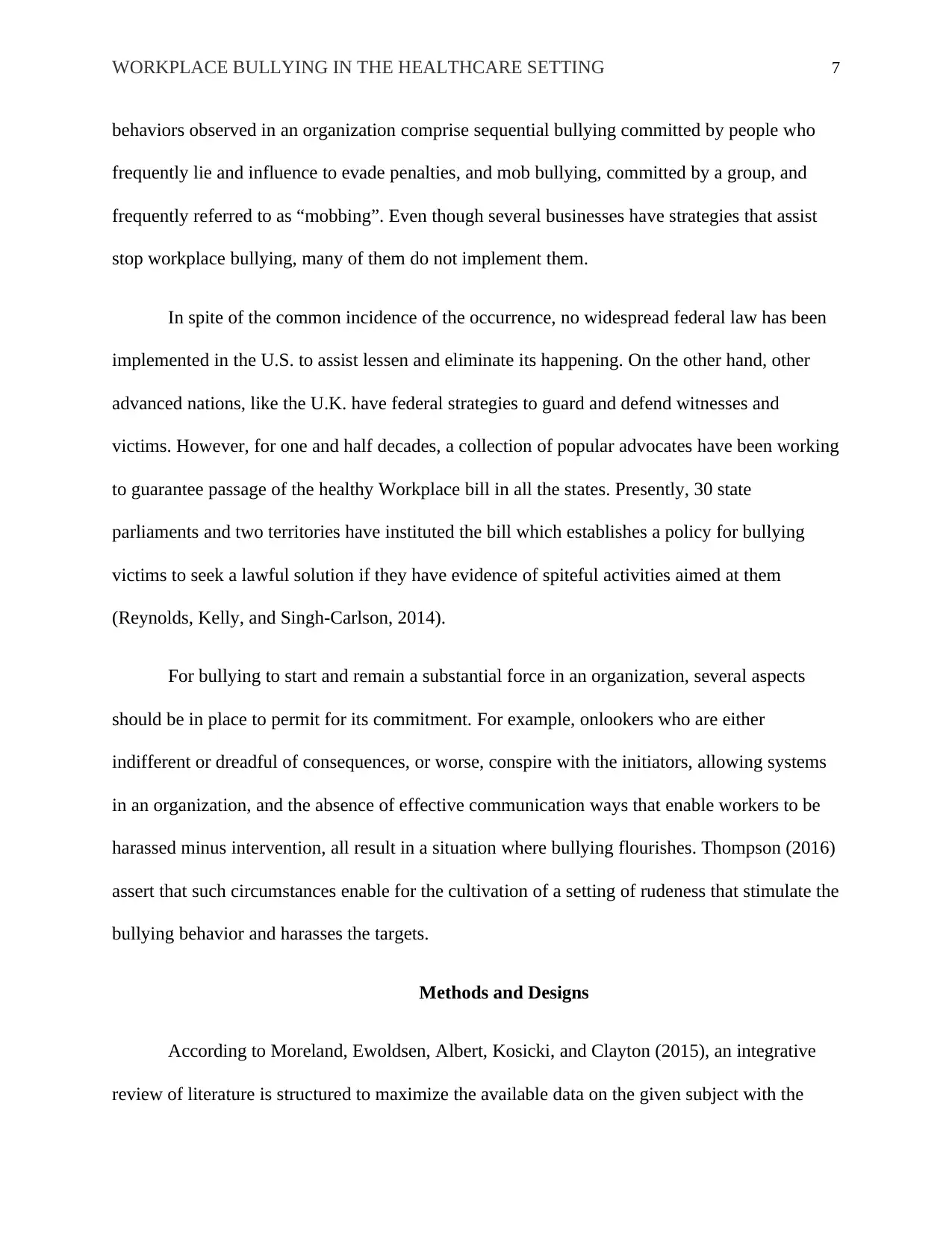
WORKPLACE BULLYING IN THE HEALTHCARE SETTING 7
behaviors observed in an organization comprise sequential bullying committed by people who
frequently lie and influence to evade penalties, and mob bullying, committed by a group, and
frequently referred to as “mobbing”. Even though several businesses have strategies that assist
stop workplace bullying, many of them do not implement them.
In spite of the common incidence of the occurrence, no widespread federal law has been
implemented in the U.S. to assist lessen and eliminate its happening. On the other hand, other
advanced nations, like the U.K. have federal strategies to guard and defend witnesses and
victims. However, for one and half decades, a collection of popular advocates have been working
to guarantee passage of the healthy Workplace bill in all the states. Presently, 30 state
parliaments and two territories have instituted the bill which establishes a policy for bullying
victims to seek a lawful solution if they have evidence of spiteful activities aimed at them
(Reynolds, Kelly, and Singh-Carlson, 2014).
For bullying to start and remain a substantial force in an organization, several aspects
should be in place to permit for its commitment. For example, onlookers who are either
indifferent or dreadful of consequences, or worse, conspire with the initiators, allowing systems
in an organization, and the absence of effective communication ways that enable workers to be
harassed minus intervention, all result in a situation where bullying flourishes. Thompson (2016)
assert that such circumstances enable for the cultivation of a setting of rudeness that stimulate the
bullying behavior and harasses the targets.
Methods and Designs
According to Moreland, Ewoldsen, Albert, Kosicki, and Clayton (2015), an integrative
review of literature is structured to maximize the available data on the given subject with the
behaviors observed in an organization comprise sequential bullying committed by people who
frequently lie and influence to evade penalties, and mob bullying, committed by a group, and
frequently referred to as “mobbing”. Even though several businesses have strategies that assist
stop workplace bullying, many of them do not implement them.
In spite of the common incidence of the occurrence, no widespread federal law has been
implemented in the U.S. to assist lessen and eliminate its happening. On the other hand, other
advanced nations, like the U.K. have federal strategies to guard and defend witnesses and
victims. However, for one and half decades, a collection of popular advocates have been working
to guarantee passage of the healthy Workplace bill in all the states. Presently, 30 state
parliaments and two territories have instituted the bill which establishes a policy for bullying
victims to seek a lawful solution if they have evidence of spiteful activities aimed at them
(Reynolds, Kelly, and Singh-Carlson, 2014).
For bullying to start and remain a substantial force in an organization, several aspects
should be in place to permit for its commitment. For example, onlookers who are either
indifferent or dreadful of consequences, or worse, conspire with the initiators, allowing systems
in an organization, and the absence of effective communication ways that enable workers to be
harassed minus intervention, all result in a situation where bullying flourishes. Thompson (2016)
assert that such circumstances enable for the cultivation of a setting of rudeness that stimulate the
bullying behavior and harasses the targets.
Methods and Designs
According to Moreland, Ewoldsen, Albert, Kosicki, and Clayton (2015), an integrative
review of literature is structured to maximize the available data on the given subject with the
Paraphrase This Document
Need a fresh take? Get an instant paraphrase of this document with our AI Paraphraser
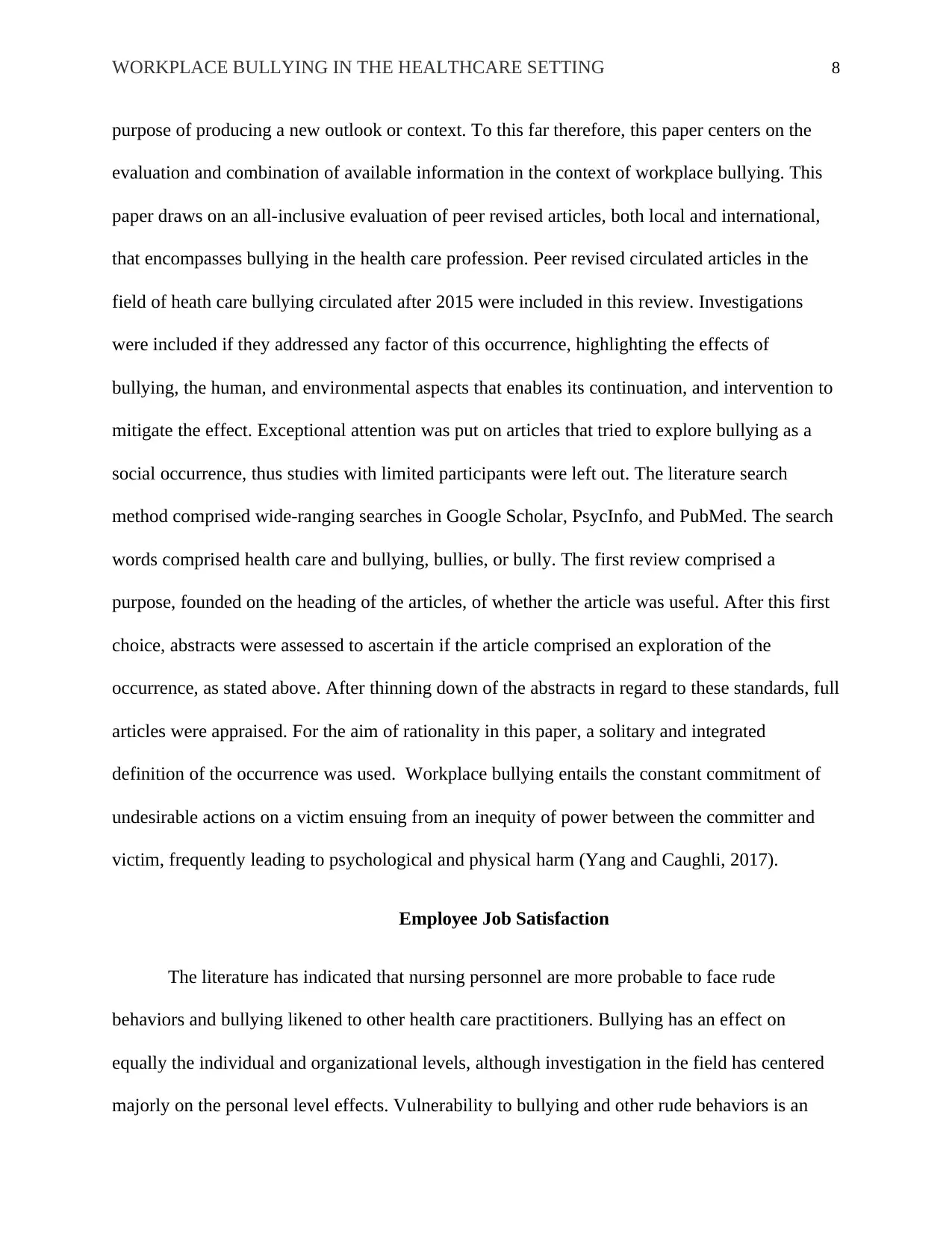
WORKPLACE BULLYING IN THE HEALTHCARE SETTING 8
purpose of producing a new outlook or context. To this far therefore, this paper centers on the
evaluation and combination of available information in the context of workplace bullying. This
paper draws on an all-inclusive evaluation of peer revised articles, both local and international,
that encompasses bullying in the health care profession. Peer revised circulated articles in the
field of heath care bullying circulated after 2015 were included in this review. Investigations
were included if they addressed any factor of this occurrence, highlighting the effects of
bullying, the human, and environmental aspects that enables its continuation, and intervention to
mitigate the effect. Exceptional attention was put on articles that tried to explore bullying as a
social occurrence, thus studies with limited participants were left out. The literature search
method comprised wide-ranging searches in Google Scholar, PsycInfo, and PubMed. The search
words comprised health care and bullying, bullies, or bully. The first review comprised a
purpose, founded on the heading of the articles, of whether the article was useful. After this first
choice, abstracts were assessed to ascertain if the article comprised an exploration of the
occurrence, as stated above. After thinning down of the abstracts in regard to these standards, full
articles were appraised. For the aim of rationality in this paper, a solitary and integrated
definition of the occurrence was used. Workplace bullying entails the constant commitment of
undesirable actions on a victim ensuing from an inequity of power between the committer and
victim, frequently leading to psychological and physical harm (Yang and Caughli, 2017).
Employee Job Satisfaction
The literature has indicated that nursing personnel are more probable to face rude
behaviors and bullying likened to other health care practitioners. Bullying has an effect on
equally the individual and organizational levels, although investigation in the field has centered
majorly on the personal level effects. Vulnerability to bullying and other rude behaviors is an
purpose of producing a new outlook or context. To this far therefore, this paper centers on the
evaluation and combination of available information in the context of workplace bullying. This
paper draws on an all-inclusive evaluation of peer revised articles, both local and international,
that encompasses bullying in the health care profession. Peer revised circulated articles in the
field of heath care bullying circulated after 2015 were included in this review. Investigations
were included if they addressed any factor of this occurrence, highlighting the effects of
bullying, the human, and environmental aspects that enables its continuation, and intervention to
mitigate the effect. Exceptional attention was put on articles that tried to explore bullying as a
social occurrence, thus studies with limited participants were left out. The literature search
method comprised wide-ranging searches in Google Scholar, PsycInfo, and PubMed. The search
words comprised health care and bullying, bullies, or bully. The first review comprised a
purpose, founded on the heading of the articles, of whether the article was useful. After this first
choice, abstracts were assessed to ascertain if the article comprised an exploration of the
occurrence, as stated above. After thinning down of the abstracts in regard to these standards, full
articles were appraised. For the aim of rationality in this paper, a solitary and integrated
definition of the occurrence was used. Workplace bullying entails the constant commitment of
undesirable actions on a victim ensuing from an inequity of power between the committer and
victim, frequently leading to psychological and physical harm (Yang and Caughli, 2017).
Employee Job Satisfaction
The literature has indicated that nursing personnel are more probable to face rude
behaviors and bullying likened to other health care practitioners. Bullying has an effect on
equally the individual and organizational levels, although investigation in the field has centered
majorly on the personal level effects. Vulnerability to bullying and other rude behaviors is an
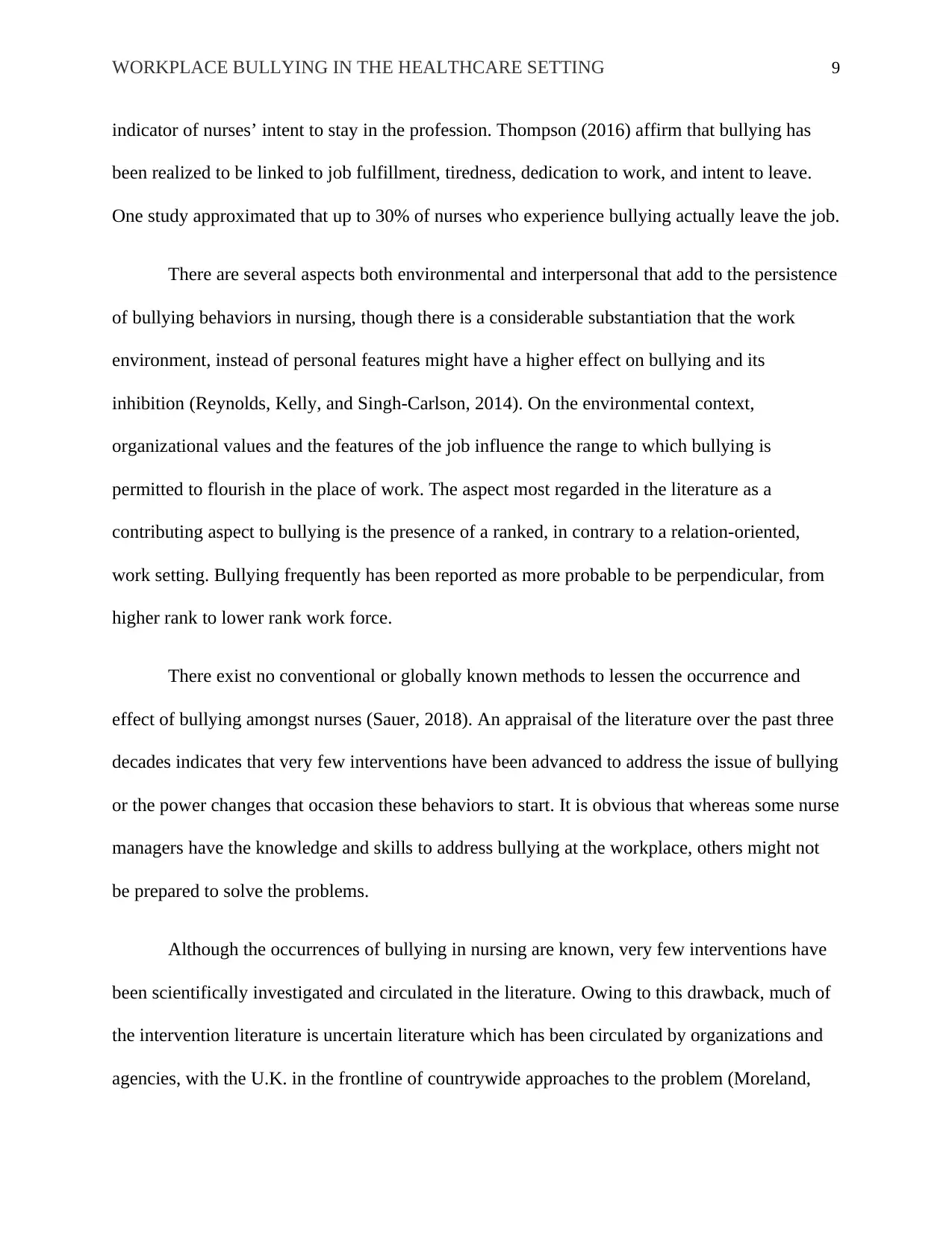
WORKPLACE BULLYING IN THE HEALTHCARE SETTING 9
indicator of nurses’ intent to stay in the profession. Thompson (2016) affirm that bullying has
been realized to be linked to job fulfillment, tiredness, dedication to work, and intent to leave.
One study approximated that up to 30% of nurses who experience bullying actually leave the job.
There are several aspects both environmental and interpersonal that add to the persistence
of bullying behaviors in nursing, though there is a considerable substantiation that the work
environment, instead of personal features might have a higher effect on bullying and its
inhibition (Reynolds, Kelly, and Singh-Carlson, 2014). On the environmental context,
organizational values and the features of the job influence the range to which bullying is
permitted to flourish in the place of work. The aspect most regarded in the literature as a
contributing aspect to bullying is the presence of a ranked, in contrary to a relation-oriented,
work setting. Bullying frequently has been reported as more probable to be perpendicular, from
higher rank to lower rank work force.
There exist no conventional or globally known methods to lessen the occurrence and
effect of bullying amongst nurses (Sauer, 2018). An appraisal of the literature over the past three
decades indicates that very few interventions have been advanced to address the issue of bullying
or the power changes that occasion these behaviors to start. It is obvious that whereas some nurse
managers have the knowledge and skills to address bullying at the workplace, others might not
be prepared to solve the problems.
Although the occurrences of bullying in nursing are known, very few interventions have
been scientifically investigated and circulated in the literature. Owing to this drawback, much of
the intervention literature is uncertain literature which has been circulated by organizations and
agencies, with the U.K. in the frontline of countrywide approaches to the problem (Moreland,
indicator of nurses’ intent to stay in the profession. Thompson (2016) affirm that bullying has
been realized to be linked to job fulfillment, tiredness, dedication to work, and intent to leave.
One study approximated that up to 30% of nurses who experience bullying actually leave the job.
There are several aspects both environmental and interpersonal that add to the persistence
of bullying behaviors in nursing, though there is a considerable substantiation that the work
environment, instead of personal features might have a higher effect on bullying and its
inhibition (Reynolds, Kelly, and Singh-Carlson, 2014). On the environmental context,
organizational values and the features of the job influence the range to which bullying is
permitted to flourish in the place of work. The aspect most regarded in the literature as a
contributing aspect to bullying is the presence of a ranked, in contrary to a relation-oriented,
work setting. Bullying frequently has been reported as more probable to be perpendicular, from
higher rank to lower rank work force.
There exist no conventional or globally known methods to lessen the occurrence and
effect of bullying amongst nurses (Sauer, 2018). An appraisal of the literature over the past three
decades indicates that very few interventions have been advanced to address the issue of bullying
or the power changes that occasion these behaviors to start. It is obvious that whereas some nurse
managers have the knowledge and skills to address bullying at the workplace, others might not
be prepared to solve the problems.
Although the occurrences of bullying in nursing are known, very few interventions have
been scientifically investigated and circulated in the literature. Owing to this drawback, much of
the intervention literature is uncertain literature which has been circulated by organizations and
agencies, with the U.K. in the frontline of countrywide approaches to the problem (Moreland,
⊘ This is a preview!⊘
Do you want full access?
Subscribe today to unlock all pages.

Trusted by 1+ million students worldwide
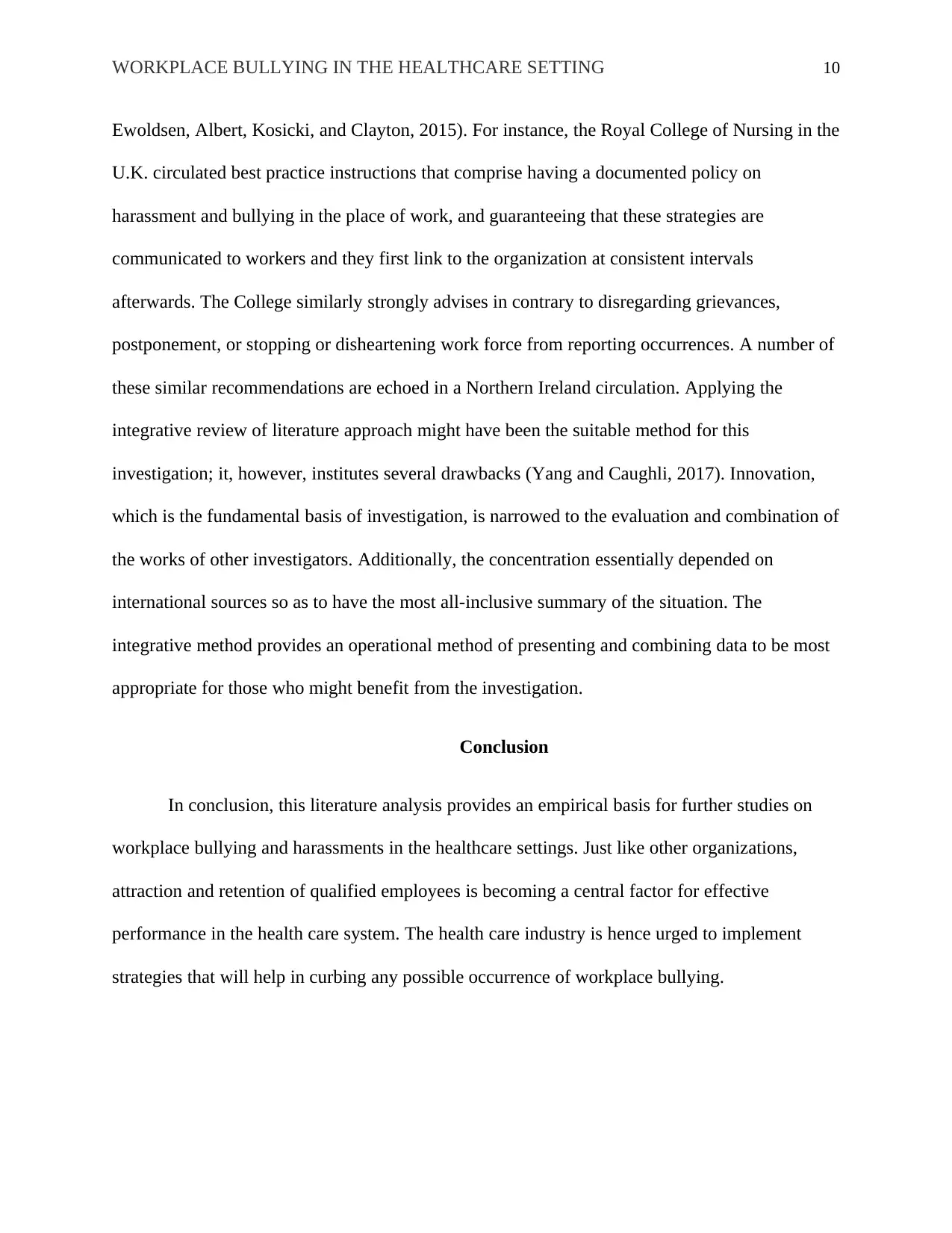
WORKPLACE BULLYING IN THE HEALTHCARE SETTING 10
Ewoldsen, Albert, Kosicki, and Clayton, 2015). For instance, the Royal College of Nursing in the
U.K. circulated best practice instructions that comprise having a documented policy on
harassment and bullying in the place of work, and guaranteeing that these strategies are
communicated to workers and they first link to the organization at consistent intervals
afterwards. The College similarly strongly advises in contrary to disregarding grievances,
postponement, or stopping or disheartening work force from reporting occurrences. A number of
these similar recommendations are echoed in a Northern Ireland circulation. Applying the
integrative review of literature approach might have been the suitable method for this
investigation; it, however, institutes several drawbacks (Yang and Caughli, 2017). Innovation,
which is the fundamental basis of investigation, is narrowed to the evaluation and combination of
the works of other investigators. Additionally, the concentration essentially depended on
international sources so as to have the most all-inclusive summary of the situation. The
integrative method provides an operational method of presenting and combining data to be most
appropriate for those who might benefit from the investigation.
Conclusion
In conclusion, this literature analysis provides an empirical basis for further studies on
workplace bullying and harassments in the healthcare settings. Just like other organizations,
attraction and retention of qualified employees is becoming a central factor for effective
performance in the health care system. The health care industry is hence urged to implement
strategies that will help in curbing any possible occurrence of workplace bullying.
Ewoldsen, Albert, Kosicki, and Clayton, 2015). For instance, the Royal College of Nursing in the
U.K. circulated best practice instructions that comprise having a documented policy on
harassment and bullying in the place of work, and guaranteeing that these strategies are
communicated to workers and they first link to the organization at consistent intervals
afterwards. The College similarly strongly advises in contrary to disregarding grievances,
postponement, or stopping or disheartening work force from reporting occurrences. A number of
these similar recommendations are echoed in a Northern Ireland circulation. Applying the
integrative review of literature approach might have been the suitable method for this
investigation; it, however, institutes several drawbacks (Yang and Caughli, 2017). Innovation,
which is the fundamental basis of investigation, is narrowed to the evaluation and combination of
the works of other investigators. Additionally, the concentration essentially depended on
international sources so as to have the most all-inclusive summary of the situation. The
integrative method provides an operational method of presenting and combining data to be most
appropriate for those who might benefit from the investigation.
Conclusion
In conclusion, this literature analysis provides an empirical basis for further studies on
workplace bullying and harassments in the healthcare settings. Just like other organizations,
attraction and retention of qualified employees is becoming a central factor for effective
performance in the health care system. The health care industry is hence urged to implement
strategies that will help in curbing any possible occurrence of workplace bullying.
Paraphrase This Document
Need a fresh take? Get an instant paraphrase of this document with our AI Paraphraser
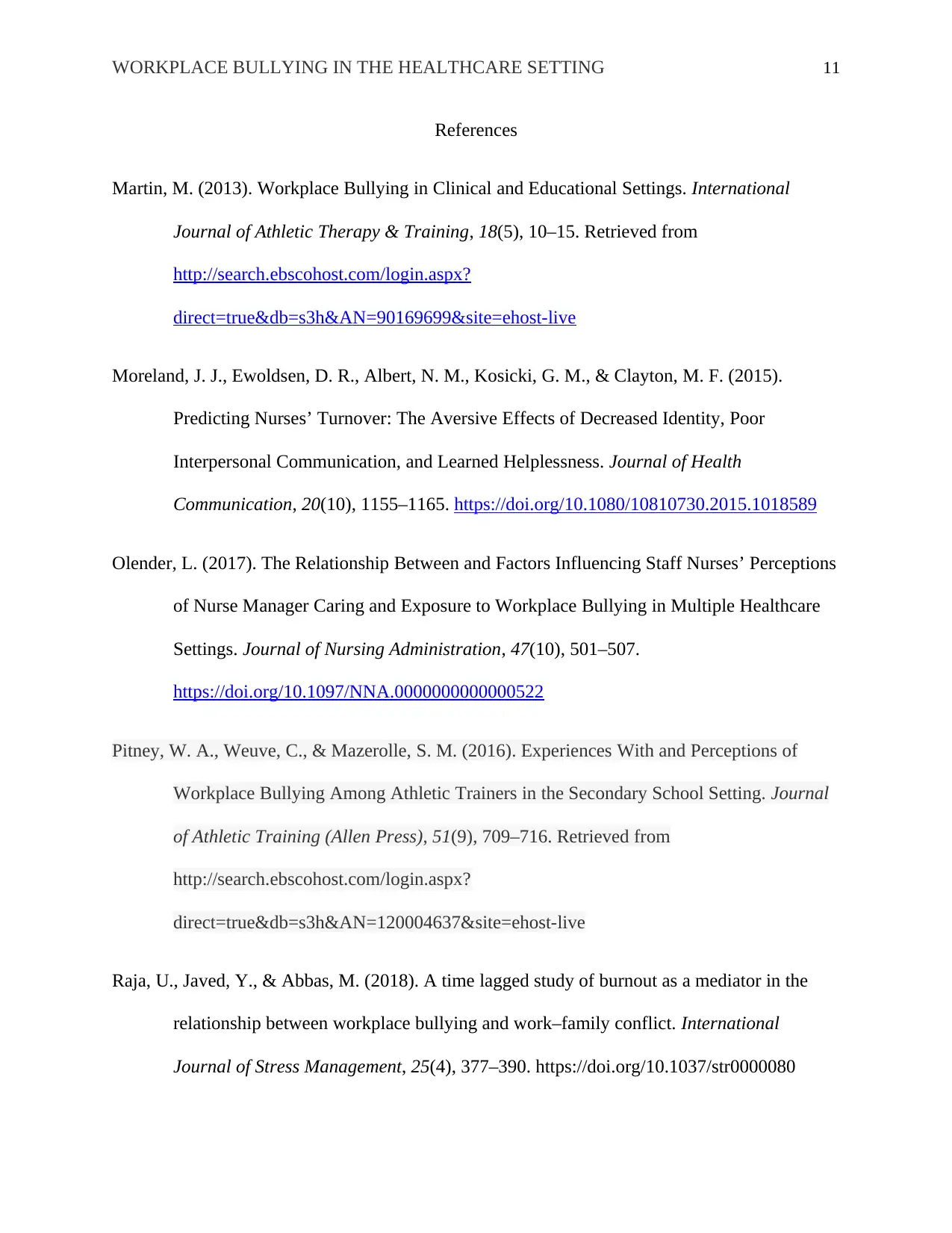
WORKPLACE BULLYING IN THE HEALTHCARE SETTING 11
References
Martin, M. (2013). Workplace Bullying in Clinical and Educational Settings. International
Journal of Athletic Therapy & Training, 18(5), 10–15. Retrieved from
http://search.ebscohost.com/login.aspx?
direct=true&db=s3h&AN=90169699&site=ehost-live
Moreland, J. J., Ewoldsen, D. R., Albert, N. M., Kosicki, G. M., & Clayton, M. F. (2015).
Predicting Nurses’ Turnover: The Aversive Effects of Decreased Identity, Poor
Interpersonal Communication, and Learned Helplessness. Journal of Health
Communication, 20(10), 1155–1165. https://doi.org/10.1080/10810730.2015.1018589
Olender, L. (2017). The Relationship Between and Factors Influencing Staff Nurses’ Perceptions
of Nurse Manager Caring and Exposure to Workplace Bullying in Multiple Healthcare
Settings. Journal of Nursing Administration, 47(10), 501–507.
https://doi.org/10.1097/NNA.0000000000000522
Pitney, W. A., Weuve, C., & Mazerolle, S. M. (2016). Experiences With and Perceptions of
Workplace Bullying Among Athletic Trainers in the Secondary School Setting. Journal
of Athletic Training (Allen Press), 51(9), 709–716. Retrieved from
http://search.ebscohost.com/login.aspx?
direct=true&db=s3h&AN=120004637&site=ehost-live
Raja, U., Javed, Y., & Abbas, M. (2018). A time lagged study of burnout as a mediator in the
relationship between workplace bullying and work–family conflict. International
Journal of Stress Management, 25(4), 377–390. https://doi.org/10.1037/str0000080
References
Martin, M. (2013). Workplace Bullying in Clinical and Educational Settings. International
Journal of Athletic Therapy & Training, 18(5), 10–15. Retrieved from
http://search.ebscohost.com/login.aspx?
direct=true&db=s3h&AN=90169699&site=ehost-live
Moreland, J. J., Ewoldsen, D. R., Albert, N. M., Kosicki, G. M., & Clayton, M. F. (2015).
Predicting Nurses’ Turnover: The Aversive Effects of Decreased Identity, Poor
Interpersonal Communication, and Learned Helplessness. Journal of Health
Communication, 20(10), 1155–1165. https://doi.org/10.1080/10810730.2015.1018589
Olender, L. (2017). The Relationship Between and Factors Influencing Staff Nurses’ Perceptions
of Nurse Manager Caring and Exposure to Workplace Bullying in Multiple Healthcare
Settings. Journal of Nursing Administration, 47(10), 501–507.
https://doi.org/10.1097/NNA.0000000000000522
Pitney, W. A., Weuve, C., & Mazerolle, S. M. (2016). Experiences With and Perceptions of
Workplace Bullying Among Athletic Trainers in the Secondary School Setting. Journal
of Athletic Training (Allen Press), 51(9), 709–716. Retrieved from
http://search.ebscohost.com/login.aspx?
direct=true&db=s3h&AN=120004637&site=ehost-live
Raja, U., Javed, Y., & Abbas, M. (2018). A time lagged study of burnout as a mediator in the
relationship between workplace bullying and work–family conflict. International
Journal of Stress Management, 25(4), 377–390. https://doi.org/10.1037/str0000080
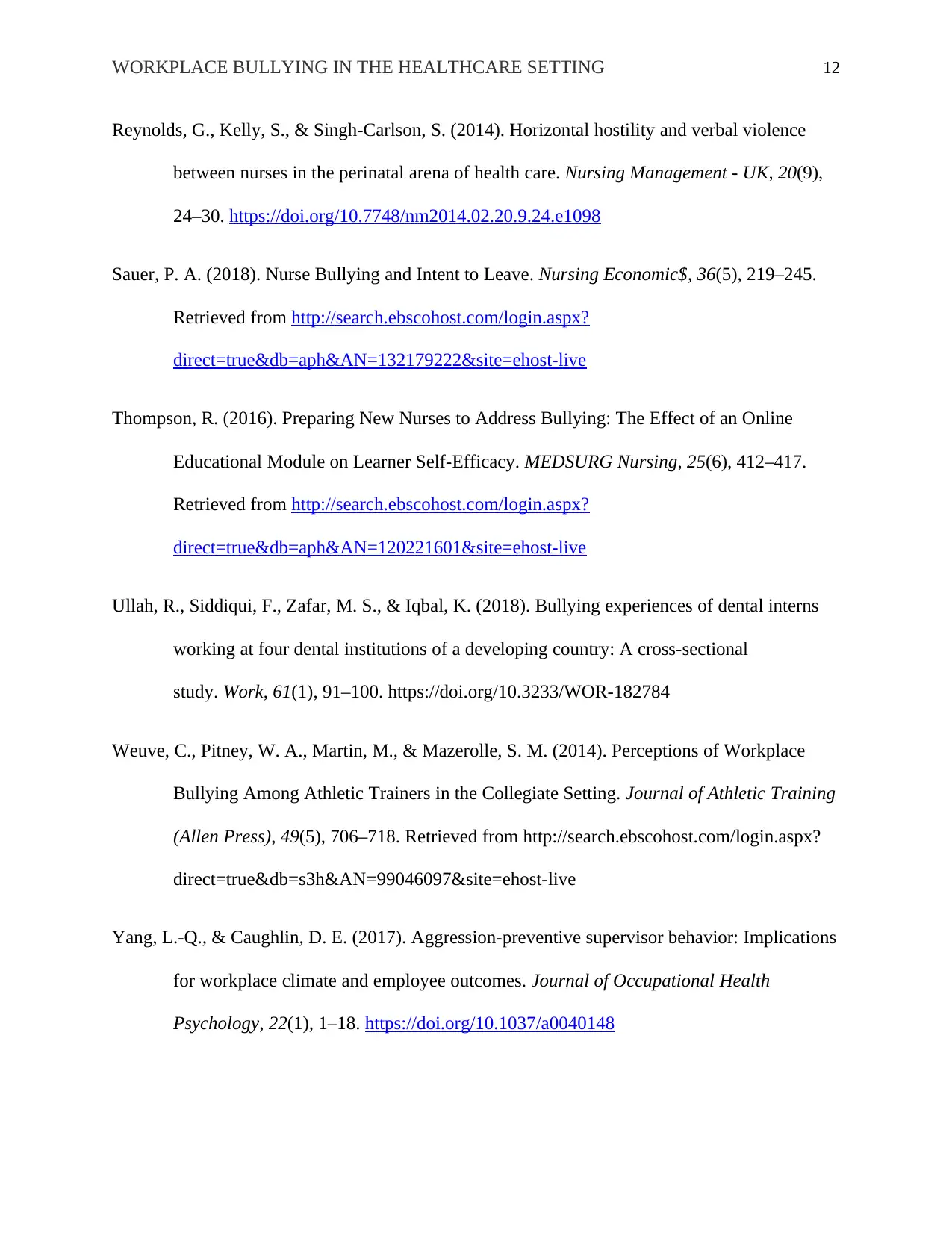
WORKPLACE BULLYING IN THE HEALTHCARE SETTING 12
Reynolds, G., Kelly, S., & Singh-Carlson, S. (2014). Horizontal hostility and verbal violence
between nurses in the perinatal arena of health care. Nursing Management - UK, 20(9),
24–30. https://doi.org/10.7748/nm2014.02.20.9.24.e1098
Sauer, P. A. (2018). Nurse Bullying and Intent to Leave. Nursing Economic$, 36(5), 219–245.
Retrieved from http://search.ebscohost.com/login.aspx?
direct=true&db=aph&AN=132179222&site=ehost-live
Thompson, R. (2016). Preparing New Nurses to Address Bullying: The Effect of an Online
Educational Module on Learner Self-Efficacy. MEDSURG Nursing, 25(6), 412–417.
Retrieved from http://search.ebscohost.com/login.aspx?
direct=true&db=aph&AN=120221601&site=ehost-live
Ullah, R., Siddiqui, F., Zafar, M. S., & Iqbal, K. (2018). Bullying experiences of dental interns
working at four dental institutions of a developing country: A cross-sectional
study. Work, 61(1), 91–100. https://doi.org/10.3233/WOR-182784
Weuve, C., Pitney, W. A., Martin, M., & Mazerolle, S. M. (2014). Perceptions of Workplace
Bullying Among Athletic Trainers in the Collegiate Setting. Journal of Athletic Training
(Allen Press), 49(5), 706–718. Retrieved from http://search.ebscohost.com/login.aspx?
direct=true&db=s3h&AN=99046097&site=ehost-live
Yang, L.-Q., & Caughlin, D. E. (2017). Aggression-preventive supervisor behavior: Implications
for workplace climate and employee outcomes. Journal of Occupational Health
Psychology, 22(1), 1–18. https://doi.org/10.1037/a0040148
Reynolds, G., Kelly, S., & Singh-Carlson, S. (2014). Horizontal hostility and verbal violence
between nurses in the perinatal arena of health care. Nursing Management - UK, 20(9),
24–30. https://doi.org/10.7748/nm2014.02.20.9.24.e1098
Sauer, P. A. (2018). Nurse Bullying and Intent to Leave. Nursing Economic$, 36(5), 219–245.
Retrieved from http://search.ebscohost.com/login.aspx?
direct=true&db=aph&AN=132179222&site=ehost-live
Thompson, R. (2016). Preparing New Nurses to Address Bullying: The Effect of an Online
Educational Module on Learner Self-Efficacy. MEDSURG Nursing, 25(6), 412–417.
Retrieved from http://search.ebscohost.com/login.aspx?
direct=true&db=aph&AN=120221601&site=ehost-live
Ullah, R., Siddiqui, F., Zafar, M. S., & Iqbal, K. (2018). Bullying experiences of dental interns
working at four dental institutions of a developing country: A cross-sectional
study. Work, 61(1), 91–100. https://doi.org/10.3233/WOR-182784
Weuve, C., Pitney, W. A., Martin, M., & Mazerolle, S. M. (2014). Perceptions of Workplace
Bullying Among Athletic Trainers in the Collegiate Setting. Journal of Athletic Training
(Allen Press), 49(5), 706–718. Retrieved from http://search.ebscohost.com/login.aspx?
direct=true&db=s3h&AN=99046097&site=ehost-live
Yang, L.-Q., & Caughlin, D. E. (2017). Aggression-preventive supervisor behavior: Implications
for workplace climate and employee outcomes. Journal of Occupational Health
Psychology, 22(1), 1–18. https://doi.org/10.1037/a0040148
⊘ This is a preview!⊘
Do you want full access?
Subscribe today to unlock all pages.

Trusted by 1+ million students worldwide
1 out of 13
Related Documents
Your All-in-One AI-Powered Toolkit for Academic Success.
+13062052269
info@desklib.com
Available 24*7 on WhatsApp / Email
![[object Object]](/_next/static/media/star-bottom.7253800d.svg)
Unlock your academic potential
Copyright © 2020–2025 A2Z Services. All Rights Reserved. Developed and managed by ZUCOL.





